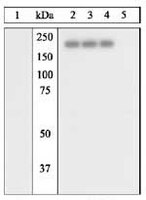324865 Sigma-AldrichPhosphoDetect™ Anti-EGFR (pTyr⁸⁴⁵) Rabbit pAb
This PhosphoDetect™ Anti-EGFR (pTyr⁸⁴⁵) Rabbit pAb is validated for use in Immunoblotting for the detection of EGFR (pTyr⁸⁴⁵).
More>> This PhosphoDetect™ Anti-EGFR (pTyr⁸⁴⁵) Rabbit pAb is validated for use in Immunoblotting for the detection of EGFR (pTyr⁸⁴⁵). Less<<MSDS (material safety data sheet) or SDS, CoA and CoQ, dossiers, brochures and other available documents.
同义词: Anti-Epidermal Growth Factor Receptor (pTyr⁸⁴⁵)
Recommended Products
概述
| Replacement Information |
|---|
重要规格表
| Species Reactivity | Host | Antibody Type |
|---|---|---|
| H | Rb | Polyclonal Antibody |
Products
| 产品目录编号 | 包装 | 数量 / 包装 | |
|---|---|---|---|
| 324865-10TCN | 塑胶安瓿;塑胶针药瓶 | 10 t |
| Product Information | |
|---|---|
| Form | Liquid |
| Formulation | In Dulbecco's PBS (w/o Mg2+ and Ca2+), 1 mg/ml BSA, 50% glycerol, pH 7.4. |
| Positive control | A431 cells stimulated with EGF |
| Preservative | ≤0.1% sodium azide |
| Quality Level | MQ100 |
| Physicochemical Information |
|---|
| Dimensions |
|---|
| Materials Information |
|---|
| Toxicological Information |
|---|
| Safety Information according to GHS |
|---|
| Safety Information |
|---|
| Product Usage Statements |
|---|
| Packaging Information |
|---|
| Transport Information |
|---|
| Supplemental Information |
|---|
| Specifications |
|---|
| Global Trade Item Number | |
|---|---|
| 产品目录编号 | GTIN |
| 324865-10TCN | 04055977215816 |
Documentation
PhosphoDetect™ Anti-EGFR (pTyr⁸⁴⁵) Rabbit pAb MSDS
| 职位 |
|---|
PhosphoDetect™ Anti-EGFR (pTyr⁸⁴⁵) Rabbit pAb 分析证书
| 标题 | 批号 |
|---|---|
| 324865 |
参考
| 参考信息概述 |
|---|
| Sieg, D.J. et al. 2000. Nat. Cell. Biol. 2, 249. Barbier, A.J. et al. 1999. J. Biol. Chem. 274, 14067. Biscardi, J.S., et al. 1999. J. Biol. Chem. 274, 8335. Hashimoto, A. et al. 1999. J. Biol. Chem. 274, 20139 Poppleton, H.M. et al. 1999. Arch. Biochem. Biophys. 363, 227. |








